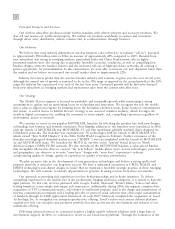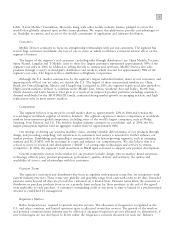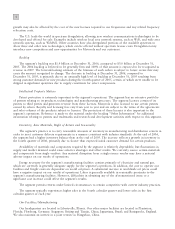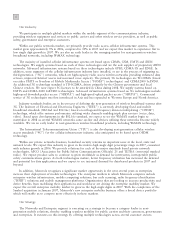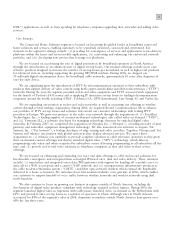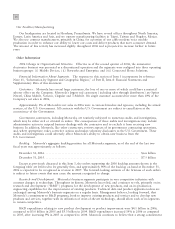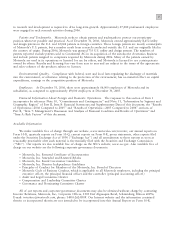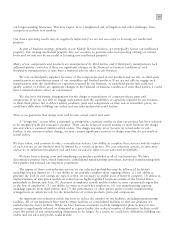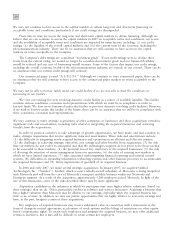Motorola 2006 Annual Report Download - page 20
Download and view the complete annual report
Please find page 20 of the 2006 Motorola annual report below. You can navigate through the pages in the report by either clicking on the pages listed below, or by using the keyword search tool below to find specific information within the annual report.
12
Customers
The vast majority of our sales are in the U.S., where a small number of large cable television multiple system
operators (""MSOs'') own a large portion of the cable systems and account for a significant portion of the total
capital spending in the industry. We are dependent upon a small number of customers for a significant portion of
our sales. Comcast Corporation (""Comcast'') accounted for approximately 29% of the segment's net sales in 2006.
Collectively, our five largest customers represented 54% of the segment's net sales in 2006. The loss of business in
the future from Comcast or any of the other major MSOs could have a material adverse effect on the segment's
business. Sales of video headend equipment and set-top boxes to telephone carriers accounted for approximately
11% of our revenue in 2006. The opportunity in this market segment is expected to continue to grow as carriers
around the world expand to offer video services.
Competition
The businesses in which we operate are highly competitive. The rapid technological changes occurring in each
of the markets in which we compete are expected to lead to the entry of many new competitors. Competitive
factors for our products and systems include: technology offered; product and system performance; features;
quality; delivery and availability; and price. We believe that we enjoy a strong competitive position because of our
strong relationships with major communication system operators worldwide, technological leadership and new
product development capabilities.
We compete worldwide in the market for digital set-top boxes for broadband and satellite networks. Based on
2006 annual sales, we believe we are the leading provider of digital cable set-top boxes in North America. Our
digital cable set-top boxes compete with products from a number of different companies, including: (i) those that
develop and sell products that are distributed by direct broadcast satellite (""DBS'') service providers through retail
channels, (ii) those that develop, manufacture and sell products of their own design, and (iii) those that license
technology from us or other competitors. In North America, our largest competitor is Cisco, which completed the
acquisition of Scientific-Atlanta in 2006. Other competitors in North America include ARRIS, Harmonic and
C-COR. Outside of North America, where we have a smaller market position, we compete with many equipment
suppliers, including several consumer electronics companies.
The traditional competitive environment in the North American cable market continues to evolve. As further
described below, the FCC has enacted regulations requiring separation of security functionality from set-top boxes
by July 1, 2007 to increase competition and encourage the sale of set-top boxes in the retail market. To meet this
requirement, we have developed security modules for sale to cable operators for use with our own and third-party
set-top boxes. As a step towards this implementation, in 2002, the cable industry and consumer electronic
manufacturers agreed to a uni-directional security interface that allows third-party devices to access broadcast
programming (not pay-per-view or VOD) with a security device. These devices became widely available in 2004
and to date have seen limited use. The limited use of the devices has not had a significant impact on our business.
A full two-way security interface specification continues to be refined. These changes are expected to increase
competition and encourage the sale of set-top boxes to consumers in the retail market. Traditionally, cable service
providers have leased the set-top box to their customers.
We also compete worldwide in the market for broadband data and voice products. We believe that we are the
leading provider of cable modems worldwide, competing with a number of consumer electronic companies and
various original design manufacturers worldwide.
Payment Terms
Generally, our payment terms are consistent with the industry and range from 30 to 60 days in North America,
and are typically limited to 90 days in regions outside North America. Extended payment terms are provided to
customers from time to time on a limited basis. Such extended terms are isolated in nature and historically have not
related to a significant portion of our revenues.
Regulatory Matters
Many of our products are subject to regulation by the FCC or other communications regulatory agencies. In
addition, our customers and their networks, into which our products are incorporated, are subject to government
regulation. Government regulatory policies affecting either the willingness or the ability of cable operators and


